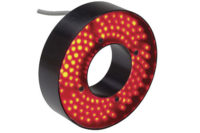It is awesome to me when a simple lighting technique can provide outstanding results on difficult problems over a large range of sizes and materials without sophisticated optics.
Of course there is a trick/technique involved: fluorescence. You shine in light of one color, another color is emitted, and you use a simple filter to separate the two colors at the sensor.
What fluoresces? Sometimes the material itself fluoresces, sometimes you “tag” a material that doesn’t fluoresce with a material that does fluoresce. The excitation wavelength is often in the near ultraviolet, but not always.
Tags can be used in large masses of materials (e.g. oil in pipe lines) or to target specific sites (e.g. DNA and brain cells).
For example:
1. Detection of oil leaks in engines and undersea, and of fine cracks (0.1 micron wide) in metals
2. On-line real-time detection and rejection of food mold
3. Detection in molecular genetics: from DNA detection to brain cell processes.
These all use fluorescence! Shine in light (e.g. UV light) and detect visible light (e.g. yellow light).
Cautions might be noted. Fluorescent intensity of some materials and tags can decrease rapidly after excitation although the decay times have been used as probes to characterize many materials.
Some tags (particularly at the cellular level) require skill at providing tags for very specific targets. Breakthroughs in research (e.g. brain cell functions) can depend on finding tags for very specific targets.
I have applied fluorescence using both natural fluorescence (food Q.A. and oil presence in mechanical watch assemblies) and commercially available tags (DNA detection for medical diagnostics and sequencing). Applications were simple, and straightforward.
Yes, I still get awed by the effectiveness, range of applications, and simplicity of appropriate optical lighting/illumination solutions.
Key words: Fluorescence, fluorometers, fluorescent detection, dye penetrant inspection, fluorescent molecules, NDT dyes, fluorescence aflatoxin, fluorophores, fluorescent DNA sequencing, Fluorescent Activated Cell Sorting (FACS), optogenetics, biophotonics, biomedical photonics.
Lighting: Fluorescence from NDT to QC to DNA
Looking for a reprint of this article?
From high-res PDFs to custom plaques, order your copy today!



